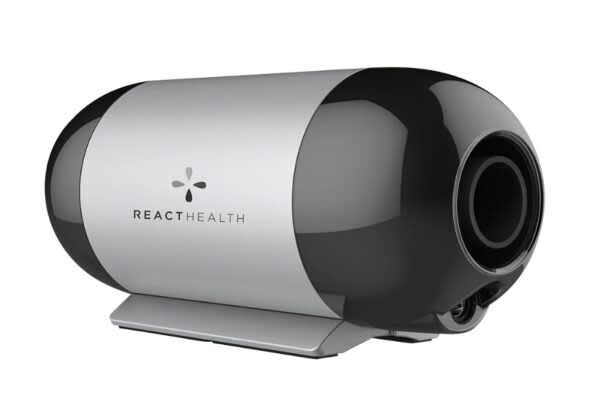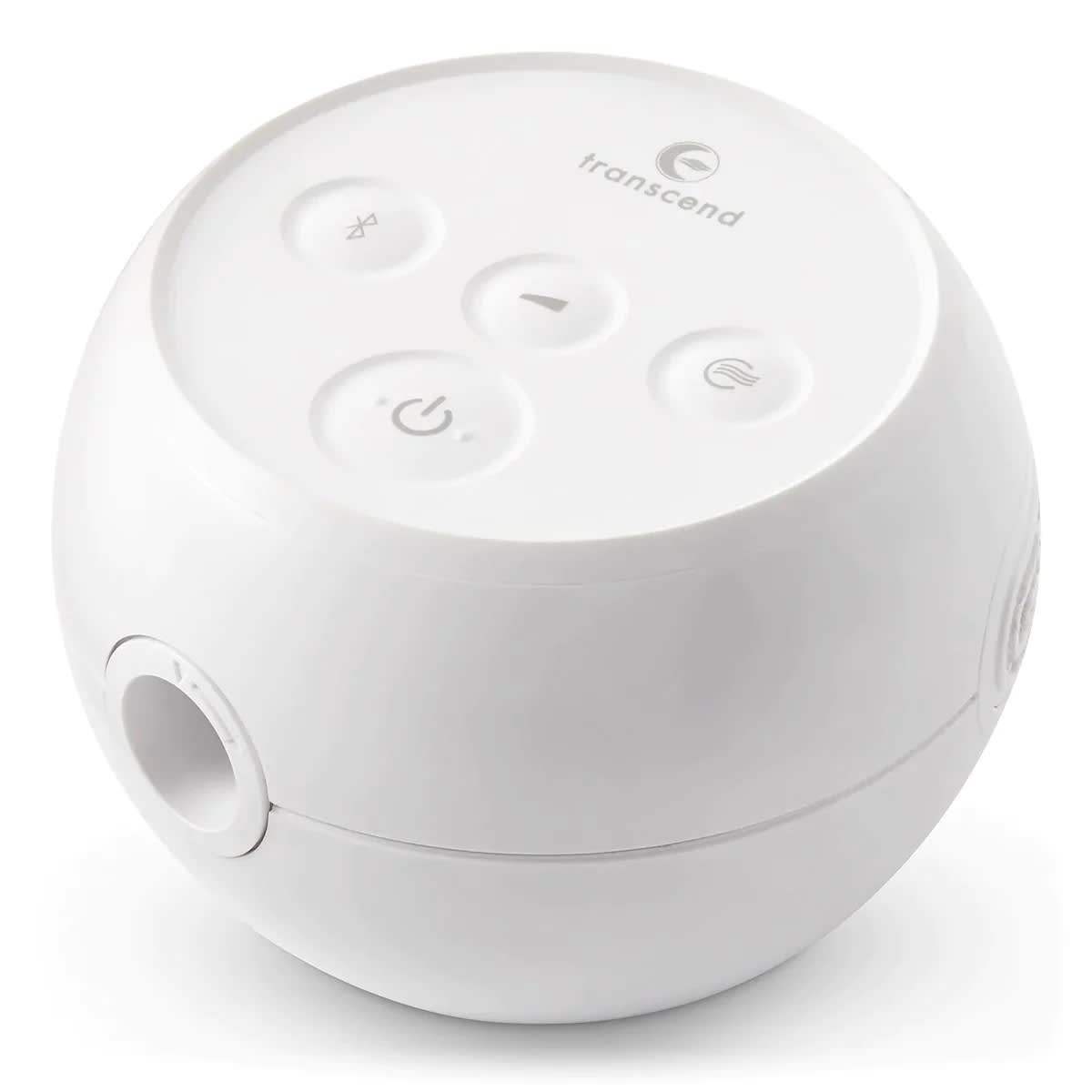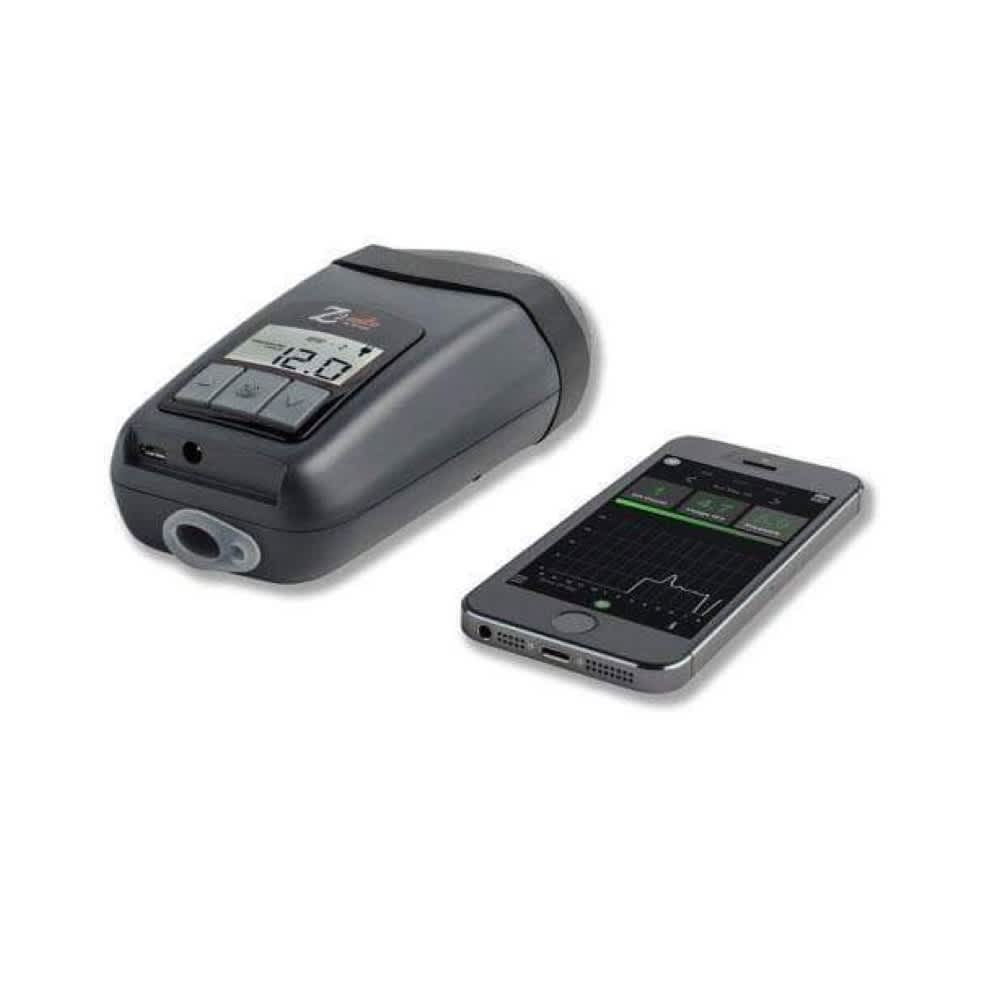On This Page
The Best Travel CPAP Machines
Our Top Picks
-
Best Overall
ResMed AirMini -
Best Features
Luna TravelPAP -
Best for Frequent Flyers
Transcend Micro Travel Auto-CPAP -
Best Quiet Operation
Breas Z2 Auto Travel CPAP
Best Overall

The ResMed AirMini is designed to provide the comfort and performance of a full-sized PAP machine in compact form. Its smaller size and slim profile make it easy to carry in a handbag, backpack, or suitcase.
Pros & Cons
Pros
- Ramping function for increased comfort
- Waterless humidification
- Compatible with five mask options
Cons
- Only compatible with ResMed masks and tubing
- On the louder side for a CPAP machine
Full Details
Best Features

The Luna TravelPAP from React Health is loaded with helpful features to enhance your CPAP therapy while you’re on the road.
Pros & Cons
Pros
- Lightweight, compact, and FAA-approved for in-flight use
- Companion app lets you view your sleep data and set a maintenance schedule
- Ramp mode eases you into therapy up to one hour after you go to bed
Cons
- Machine does not automatically adjust pressure levels
- No humidifier and not compatible with heated tubing
Full Details
Best for Frequent Flyers

Measuring less than 4 inches wide and weighing less than half a pound, the Transcend Micro Travel Auto-CPAP takes up very little space.
Pros & Cons
Pros
- One of the smallest and lightest travel machines on the market
- GentleRise feature gradually ramps up air pressure as you fall asleep
- Auto-adjusting AirRelief reduces air pressure on exhalation
Cons
- Not compatible for people who use masks with top-of-head tubing
- Some users report the device is quite loud
Full Details
Best Quiet Operation

The Breas Z2 Auto CPAP is a small but versatile device with both CPAP and APAP modes. It includes Qlite technology designed to minimize sound in the mask, leading to a quieter sleep.
Pros & Cons
Pros
- Includes both CPAP and APAP modes
- Auto Start/Stop function begins therapy when you put on your mask and stops when you remove it
- Optional rechargeable battery keeps the device running overnight on a single charge
Cons
- Sleepers who want to use their preferred mask and tubing
- Travelers with destinations that have different voltage standards
- Those who want a simple humidification system
Full Details
How We Make Our Picks
Over the years, we’ve found that the ideal way to decide on the best CPAP machines and accessories is to combine our years of expertise with real-world performance data. Our team of sleep health professionals and researchers look at machine specifications and materials to determine compatibility, quality, and efficacy.
For this review, we also considered important factors to keep in mind while traveling, including machine size, FAA requirements, and battery options. Our top picks include models with solid brand reputations and excellent performances for real-world users. We studied verified reviews from people who use each of these models and made sure to incorporate opinions from people of all genders, sizes, and sleep preferences.
What Are the Benefits Of Using a Travel CPAP Machine?
Travel CPAP machines are small and lightweight, making them easy to pack. This portability allows sleepers to continue therapy while on the go, affording them all the advantages of CPAP use without needing to lug around a full-sized machine.
How Do Travel CPAP Machines and Standard CPAP Devices Differ?
While they deliver similar results, travel CPAP and standard CPAP machines differ in several ways.
Pricing, Sizing, and Weight
The price of standard CPAP machines varies widely. Some budget options can cost around $500, while higher-end brands can be closer to $1,000. Travel CPAP machines tend to cost more on average. It’s also worth noting that travel CPAP machines are less likely to be covered by insurance.
In general, standard CPAP machines are about the size of a small shoebox, with a length of less than a foot and a weight of around 3 or 4 pounds. Travel CPAP machines are noticeably smaller and lighter, with measurements that are often half of what you’d see for full-sized machines.
Their smaller footprint makes travel CPAP machines more attractive for when you’re on the go, and space is at a premium. This is particularly true for use on planes, where a compact machine can fit more easily on the tray or under the seat.
Compatibility With Your CPAP Accessories
CPAP machines can vary in their compatibility with masks, tubes, and other accessories. The accessories that work on a sleeper’s standard machine may use a proprietary connection that won’t fit a travel CPAP. Conversely, the travel CPAP may not have universal connectivity. In either case, sleepers will need to purchase an adapter or separate mask and hose kit made specifically for their travel CPAP.
Selecting a travel CPAP machine that fits your preferred mask and tubing can save money and help you feel more comfortable. Most brand websites list compatibility specifications for their products.
Humidifiers
Some CPAP machines have integrated or external humidifiers that add moisture to the pressurized air. Humidifiers can help keep the throat, mouth, and nasal passages from drying out and causing discomfort. However, humidifiers usually use water reservoirs, which can be bulky or cumbersome. Some travel CPAP machines get around this difficulty by using waterless humidification.
If you’re used to using a humidifier with your CPAP machine, you don’t have to go without while you travel. Some travel CPAPs have built-in humidifiers that take up very little space.
CPAP Batteries
Standard CPAP machines typically plug into the wall. Travel CPAPs also come with an AC power adapter, but many have built-in or external batteries that allow the machine to function when an outlet is not available. This can be especially helpful if you’re using a travel CPAP while camping or anywhere else where power outlets aren’t readily available. However, the addition of a battery does impact the weight and size of a travel CPAP.
Are There Travel Versions Of BiPAP or APAP Machines?
Many travel CPAP machines include APAP modes. Separate APAP and BiPAP travel machines are harder to come by, in part because they generally aren’t small enough to be conveniently portable.
How To Find the Best Travel CPAP Machine For You
There are several considerations to take into account when selecting a travel CPAP machine. You’ll want to think about your desired pressure and noise levels and determine whether you want a machine with data tracking, ramp settings, or other smart features.
Pressure Ranges and Noise Levels
| Pressure Ranges | Noise Levels |
| Travel CPAP machines typically have a pressure range of between 4 and 20 cm H2O. Most pressure prescriptions fall within this span. | Travel CPAPs usually run at a noise level that falls between 25 and 30 decibels. This is sometimes referred to as “whisper quiet” and is about on par with regular CPAP machines. |
CPAP Data Tracking, Ramp Settings, and Smart Features
| Data Tracking | Ramp Settings | Smart Features |
| Travel CPAPs may have onboard or app-based data tracking. Tracked categories can include total hours used, number of apnea events, and quality of the mask seal. Comparing data collected while traveling versus at home could offer additional insights into your therapy plan. | Some travel CPAP machines come with ramp settings. These allow the machine to gradually increase the air pressure over time until it reaches the prescribed level. The feature is designed to make it easier to fall asleep. Ramp settings can be especially handy for sleepers who have trouble falling asleep while traveling. | Many travel CPAPs are equipped with smart features that include Wi-Fi connectivity and pre-heating humidifiers. These additional benefits can increase comfort and convenience while you’re on the road. |
Can a Portable CPAP Machine Work as Your Primary CPAP Device?
Portable CPAP machines can work as your primary CPAP device, especially if they are made by a trusted brand using high-quality components. However, it’s important to note that travel CPAP machines aren’t generally designed for long-term use, so you might be better off saving them for use when you’re away from home.
If you plan to use your regular tubing and mask set up, make sure they’re compatible with the travel CPAP you have in mind. Many accessories are universally compatible, but not all.
CPAP Prescription, Insurance, and Purchase Information
Purchasing a travel CPAP machine is fairly straightforward, provided you have a prescription and an understanding of what your insurance will and won’t cover in terms of cost.
Do You Need a Prescription For a Travel CPAP Machine?
The FDA considers travel CPAPs to be Class II medical devices, meaning sleepers need a prescription in order to purchase one. Following a sleep test, a doctor’s prescription will include a pressure setting that is personalized to the sleeper.
Does Your Health Insurance or Medicare Cover the Costs of a Travel CPAP Device?
Health insurance or Medicare may cover the costs of a travel CPAP machine. However, even if your machine is covered by insurance, you may still need to pay monthly installments and provide usage data. It’s important to verify your coverage benefits and any other requirements with your insurance provider.
Where Can You Buy a Travel CPAP Machine?
Travel CPAP machines can be purchased online or in stores, and the buying process can look different depending on which option you choose.
Brand websites typically have an online storefront. There are also many web-based, third-party sleep product retailers that sell travel CPAP machines. Be sure to have your prescription and insurance information on hand so you can enter it at checkout.
Buying from a brick-and-mortar store can give you access to a knowledgeable salesperson who can help guide you through the buying process. However, some deals, sleep trials, and models may be unavailable when shopping in person.
Last Things to Think About When Traveling With CPAP Machines
Traveling with a CPAP machine doesn’t need to be complicated. As with most things, preparing ahead of time for your trip helps. This is especially important when it comes to airline travel. You’ll want to ensure that your device is FAA approved, including any external batteries or accessories. If you plan to use your machine on the plane, make sure your airline doesn’t have a notification requirement.
How Do You Pack a CPAP Machine for Air Travel?
It’s best not to pack your CPAP machine in checked baggage to protect it from getting lost, stolen, or broken. However, your CPAP machine must be FAA approved in order for you to bring it on board. Flyers can also carry their CPAP in a separate bag or case, which, according to FAA regulations, won’t count toward a carry-on limit.
If you use a humidifier, make sure it’s empty, and plan to refill it with distilled water at your destination.
How Do You Travel Internationally With a CPAP Machine?
International travelers who want to use a CPAP while abroad should keep varying outlet sizes and power inputs in mind. Check to see if a converter is needed to plug your CPAP into the wall. You’ll also want to double-check your machine’s voltage requirements.
